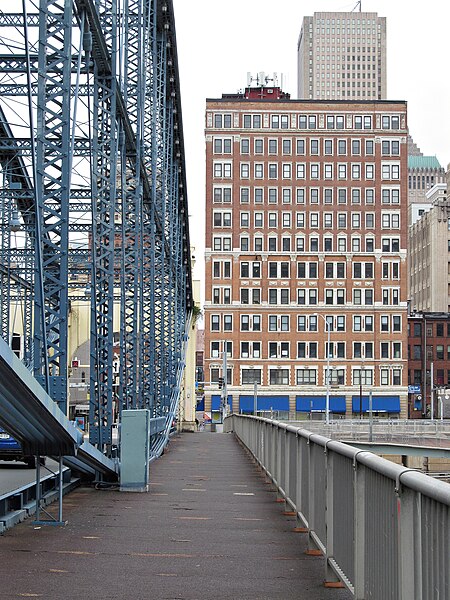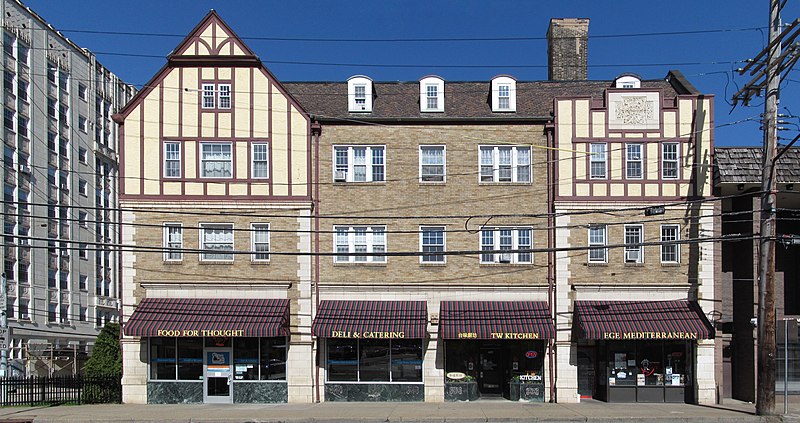
-
Sixth Presbyterian Church, Squirrel Hill, in 1994

One of the many black stone buildings that still remained in Pittsburgh in the 1990s. Like almost all the others, Sixth Presbyterian has since been cleaned and restored to its original color.
Father Pitt has always wondered why the Presbyterians kept numbering their churches. “First Presbyterian” is an honorable distinction. “Fifth Presbyterian” just sounds tired. And then why stop at six? There is a Seventh Presbyterian in Cincinnati, for example.
-
Cola Street

These houses on Cola Street (and a couple on William Street behind it) are in various styles and come from various eras. But they all either were built or have been adapted for one main purpose: to suck in as much of the magnificent skyline view as possible.
The name “Cola Street” is odd. Apparently it was originally “Coal Street”; did it succumb to a persistent typographical error?
-
Fifth Avenue in 2001

How things have changed in two decades! Fifth Avenue at the turn of our century was a busy and fairly low-class retail district, instead of the somewhat less busy but much tonier row of specialty boutiques it is now. Above, we look eastward toward the shiny new Lazarus department store, soon to go bust. At this point there were four department stores downtown, which proved to be about four more than the traffic could support. Below, the G. C. Murphy five-and-dime store, which proudly claimed to be the world’s largest variety store, and Candy-Rama, whose sign was probably bigger than the store itself. Note also the last incarnation of a hat shop (formerly Tucker & Tucker) that had been at the same location for decades.


One thing has not changed at all: Pittsburghers have always been inveterate jaywalkers. Note the crowds crossing before the light has changed.

On the left, Kaufmann’s, the biggest department store there ever was in Pittsburgh, with fourteen floors of everything. On the right, Lord & Taylor, which didn’t last very long here.
Old Pa Pitt has gone rummaging in old boxes of slides and binders of negatives, so you will see more of these old pictures over the next few weeks. The pictures in this article were taken with a pair of Communist cameras: a Soviet Zenit-B and an East German Praktiflex.
-
The House Building (and the Smithfield Street Bridge)

The House Building (1902, architect James T. Steen) looms before us as we cross the Smithfield Street Bridge.

-
Craig Street Face of Bayard Manor

The western end of Bayard Manor faces Craig Street. This is the commercial front of the building, since Craig Street is a retail district. The building has a residential front on Bayard Street, which matches the style of this end but does not even hint at sordid commerce. Father Pitt also has perhaps the only picture on the Internet of the entire Bayard Street front of Bayard Manor.
-
St. Leo’s, Marshall-Shadeland

If he had known that the church would be demolished the next year, Father Pitt would have been more careful to document it. As it is, he happened to be passing in 2001 with one of his many odd old cameras, and he decided to take this quick picture before rolling on. The architect was Frederick Sauer; the church was built in 1906.1
The church had been vacant for several years when the Sisters of Divine Providence demolished it and built a new Family Support Center. The front of that building bears a mural with a picture of St. Leo’s in it.
- Source: Pittsburgh Press, February 6, 1906. “Architect F. C. Sauer, No. 804 Penn avenue, will close bids March 1 for the foundation for the St. Leo Church on Brighton road, Allegheny, Pa.” In a previous version of this article, Father Pitt had written, “The architect was probably John T. Comès, who gave this German congregation an Italian Romanesque church, because why not?” The attribution was based on a secondary source, but our primary source is decisive. ↩︎
-
Commercial Building in Beechview

This building sits at the complicated corner where Broadway, Hampshire Avenue, and Beechview Avenue come together. Except for the ground floor in the front, it has changed little since it was put up as one of the first commercial buildings in the neighborhood. For many years the fondly remembered Johns’ Drugs (the apostrophe could have gone either way, since the founder was John A. Johns) was here.
We mentioned “the ground floor in the front” because, like many Beechview buildings, this has ground floors on more than one level. On the Hampshire Avenue side is a little speakeasy in what would be the basement level if the ground were flat.

The street sign with “Hampshire St” is anomalous. The street is called “Hampshire Ave” on other signs, including the one across Broadway. Most streets are “avenues” in Beechview, even if the “avenue” is a concrete stairway.


